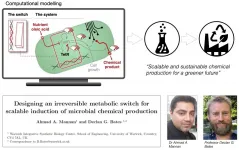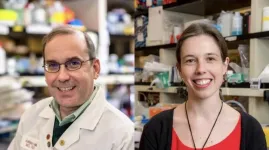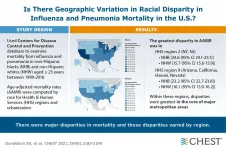(Press-News.org) DURHAM, N.C. - Using drones and artificial intelligence to monitor large colonies of seabirds can be as effective as traditional on-the-ground methods, while reducing costs, labor and the risk of human error, a new study finds.
Scientists at Duke University and the Wildlife Conservation Society (WCS) used a deep-learning algorithm--a form of artificial intelligence--to analyze more than 10,000 drone images of mixed colonies of seabirds in the Falkland Islands off Argentina's coast.
The Falklands, also known as the Malvinas, are home to the world's largest colonies of black-browed albatrosses (Thalassarche melanophris) and second-largest colonies of southern rockhopper penguins (Eudyptes c. chrysocome). Hundreds of thousands of birds breed on the islands in densely interspersed groups.
The deep-learning algorithm correctly identified and counted the albatrosses with 97% accuracy and the penguins with 87%. All told, the automated counts were within 5% of human counts about 90% of the time.
"Using drone surveys and deep learning gives us an alternative that is remarkably accurate, less disruptive and significantly easier. One person, or a small team, can do it, and the equipment you need to do it isn't all that costly or complicated," said Madeline C. Hayes, a remote sensing analyst at the Duke University Marine Lab, who led the study.
Monitoring the colonies, which are located on two rocky, uninhabited outer islands, has until now been done by teams of scientists who count the number of each species they observe on a portion of the islands and extrapolate those numbers to get population estimates for the full colonies. Because the colonies are large and densely interspersed and the penguins are much smaller than the albatrosses (and, thus, easy to miss), counts often need to be repeated. It's a laborious process, and the presence of the scientists can disrupt the birds' breeding and parenting behaviors.
To conduct the new surveys, WCS scientists used an off-the-shelf consumer drone to collect more than 10,000 individual photos, which Hayes converted into a large-scale composite visual using image-processing software.
She then analyzed the image using a convolutional neural network (CNN), a type of AI that employs a deep-learning algorithm to analyze an image and differentiate and count the objects it "sees" in it - in this case, two different species of sea birds. These counts were added together to create comprehensive estimates of the total number of birds found in colonies.
"A CNN is loosely modeled on the human neural network, in that it learns from experience," said David W. Johnston, director of the Duke Marine Robotics and Remote Sensing Lab. "You train the computer to pick up on different visual patterns, like those made by black-browed albatrosses or southern rockhopper penguins in sample images, and over time it learns how to identify the objects forming those patterns in other images such as our composite photo."
Johnston, who is also associate professor of the practice of marine conservation ecology at Duke's Nicholas School of the Environment, said the emerging drone- and CNN-enabled approach is widely applicable "and greatly increases our ability to monitor the size and health of seabird colonies worldwide, and the health of the marine ecosystems they inhabit."
Guillermo Harris, senior conservationist at WCS, co-authored the study. He said, "Counting large seabird colonies of mixed species at remote locations has been an ongoing challenge for conservationists. This technology will contribute to regular population assessments of some species, helping us better understand whether conservation efforts are working."
Crafting and training the CNN can seem intimidating, Hayes noted, but "there are tons of online resources to help you, or, if you don't want to deal with that, you can use a free, pre-built CNN and customize it to do what you need. With a little patience and guidance, anyone could do it. In fact, the code to recreate our models is available online to help other researchers kickstart their work."
INFORMATION:
The scientists published their peer-reviewed findings May 22 in Ornithological Applications.
The two islands used for the pilot study, Grand Jason Island and Steeple Jason Island, are owned and operated as a private nature reserve by WCS.
Additional coauthors of the paper were Patrick Gray of Duke, Wade Sedgwick and Vivon Crawford of WCS, Natalie Chazal of North Carolina State University and Sarah Crofts of Falklands Conservation.
Funding came from WCS, the Island Foundation, the Francis Goelet Charitable Trust and Robert G. Goelet.
CITATION: "Drones and Deep Learning Produce Accurate and Efficient Monitoring of Large-Scale Seabird Colonies," Madeline C. Hayes, Patrick C. Gray, Guillermo Harris, Wade C. Sedgwick, Vivon D. Crawford, Natalie Chazal, Sarah Crofts and David W. Johnston.
Ornithological Applications, May 22, 2021. DOI: 10.1093/ornithapp/duab022
Researchers from the University of Liège (Belgium) have recently developed a new artificial neuron inspired by the different modes of operation of human neurons. Called a Bistable Recurrent Cell (BRC), this process has enabled recurrent networks to learn temporal relationships of more than a thousand discrete time units where classical methods failed after only a hundred time units. These important results are published in the journal PLOS One.
The enormous interest in artificial intelligence (AI) in recent years has led to the development of extremely powerful machine learning techniques. For example, time series - any series of data where a time component is ...
The speed of water flow is a limiting factor in many membrane-based industrial processes, including desalination, molecular separation and osmotic power generation.
Researchers at The University of Manchester's National Graphene Institute (NGI) have published a study in Nature Communications showing a dramatic decrease in friction when water is passed through nanoscale capillaries made of graphene, whereas those with hexagonal boron nitride (hBN) - which has a similar surface topography and crystal structure as graphene - display high friction.
The team also demonstrated that water velocity could be selectively controlled by covering the high friction hBN channels with graphene, opening ...
DURHAM, N.H.--Why did the deer cross the road? According to research from the University of New Hampshire to keep going and going and going. Researchers have discovered the longest distance ever recorded by an adult male white-tailed deer--300 kilometers, or close to 200 miles, in just over three weeks. The finding has important implications for population management and the transmission of disease, especially chronic wasting disease, a fatal neurological disease.
"Deer are one of the most abundant, well-known and intensely managed species of wildlife in the United States," said Remington Moll, assistant ...
The bad odors produced by the Waste Water Treatment Plants, known as WWTPs, have become a growing concern in the cities and towns that host these facilities and are considered by citizens to be the main cause of the perception of pollution, along with the dust and noise.
Now, and thanks to a collaboration between the Institute for Bioengineering of Catalonia (IBEC) and the company DAM, a new way is being opened to detect and treat these odors.
According to the researchers, "the results obtained in the SNIFFDRONE project (Odor monitoring by drones for environmental purposes) are very positive and represent a significant advance ...
- Most high-value chemicals are currently produced using fossil fuels - industrial chemistry's use of petroleum accounts for 14% of all greenhouse gas emissions.
- An exciting alternative is to engineer bacteria as "cell-factories" with a genetic switch that reroutes their chemistry to produce high-value chemicals, such as biofuels, polymers and pharmaceuticals.
- The use of expensive chemicals to switch them on severely limits their commercial potential, researchers have used mathematical models to develop a new genetic switch that can use a cheap natural ...
JUNE 8, 2021, NEW YORK - A study conducted by researchers at the Ludwig Center at Harvard has demonstrated how a drug screening method known as dynamic BH3 profiling can be used to quickly identify potentially effective combinations of existing drugs for personalized cancer therapy.
"We know that cancer cells and healthy cells have different metabolisms," said Ludwig Harvard investigator Anthony Letai who, with former postdoctoral researcher Veerle Daniels, led the study reported in the current issue of Science Signaling. "Using BH3 profiling, we found a specific metabolic dependency in triple ...
Published monthly, the journal CHEST® features peer-reviewed, cutting-edge original research in chest medicine: Pulmonary, critical care, sleep medicine and related disciplines. Journal topics include asthma, chest infections, COPD, critical care, diffuse lung disease, education and clinical practice, pulmonology and cardiology, sleep and thoracic oncology.
The June issue of CHEST includes 95 articles, clinically relevant research, reviews, case series, commentary and more. Each month, the journal also offers END ...
A new Alzheimer's disease drug will hit the market soon, the first in nearly two decades. But some experts say the evidence for it isn't terribly strong and worry that it may cost a lot.
Still, the announcement of its approval by the U.S. Food and Drug Administration made headlines nationwide. The attention reflects the toll dementia takes on patients, families and society, and the lack of good treatment options.
Meanwhile, millions of adults could lower the chance that they'll ever need a drug like that. To do so, they will need to work with their primary care providers and use the power ...
There is a growing body of evidence supporting airborne transmission of SARS-CoV-2, the virus that causes COVID-19. Despite updates from the World Health Organization, the U.S. Centers for Disease Control and Prevention (CDC) and the Public Health Agency of Canada that the virus can be transmitted by short- and long-range aerosols, Canada's public health guidance has not been adequately updated to address this mode of transmission, argue authors of a commentary published in CMAJ (Canadian Medical Association Journal)
Canadian public health guidance and practices should be updated to include more emphasis on the following airborne mitigation measures: ventilation, filtration and better masks.
"Ventilation is a key element in the fight against airborne transmission. We need clear guidelines ...
Researchers at the University of Illinois Chicago have shown that even after lung tissue has been damaged, it may be possible to reverse fibrosis and promote tissue repair through treatment with microgel-coated mesenchymal stromal cells.
Pulmonary fibrosis is a chronic disease caused by environmental toxins, medications or medical conditions like pneumonia and rheumatoid arthritis. It is characterized by the formation of scar tissue due to damage or an unchecked immune response, and it can cause mild to severe difficulty breathing and oxygen deprivation. Fibrosis ...






